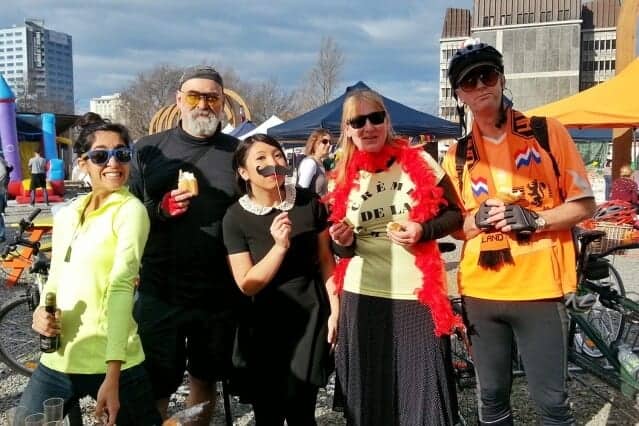“It’s the community engagement that’s most important,” says Lily Bui, a recent graduate of MIT’s Comparative Media Studies program and a PhD candidate in the Department of Urban Studies and Planning. She has long been interested in how to engage people in technology-driven change.
There is no doubt that technology has transformed the way we interact with the world. Since the rise of the smartphone and the boom of applications that came with it, handheld devices have created a new technological revolution and transformed daily life. On average, most people check their phones over one hundred times a day. Many applications utilize these interactions, not only to improve the app itself, but to crowdsource data for the benefit of humanity. Science has also begun to tap into this powerhouse of data acquisition through projects that request input from members of the general public.
Ever since Bui’s first exposure to citizen science, she has been excited by the process of enabling people who are non-experts to go out in the field and help collect data. For example, a citizen science project might request contributors to record qualitative observations about the weather, or to collect data through open source sensors that can quantitatively measure factors like air and water quality.
Bui began to explore where open source sensors might be used to supplement institutionally-backed data collection. She decided to pursue urban planning and design: “There’s a need for more data about how cities are being used, how infrastructure affects behavior, and how environmental factors will also be part of that system.”
Christchurch, New Zealand, presented an opportunity to engage this ambition. The city was destroyed in a record-breaking earthquake in 2011. Because of the extent of the damage, Christchurch, once New Zealand’s second most populous city, faced a unique challenge and opportunity to rebuild their city in any way they desired.
Sensing City, a nonprofit organization, set out to help Christchurch become the world’s first “smart city.” Their envisioned city would use data collected from citizens and various air and water quality sensors to better understand the urban environment and to make decisions about how to reduce inefficiencies in city building.
Bui’s work with Sensing City primarily focused on collecting data from cyclists to decide where bike lanes were most needed. Christchurch has deep cultural ties to cycling, which had been a primary means of transportation in the 1970s. As the city’s population rapidly grew, cars began to dominate the road, making it unsafe to bike. However, in the wake of the earthquake’s destruction of nearly all roadways, people got back in touch with cycling and have a strong desire to integrate bike lanes into the road plan and make cycling a major part of their city once more.
To help understand what bike paths are most needed by those living in Christchurch, Bui designed an app that tracked cyclists’ paths using GPS. But her work did not end there; she also needed to attract a broad user base to collect meaningful data. In order to motivate citizens to actually use the application, Bui involved Christchurch cyclists in the design and launch.
The application was released with a GPS painting event, where cyclists use their route to form a picture or shape on a virtual map. The community selected to sketch a ‘C’ for Christchurch that also resembled the Arc de Triomphe, where the Tour de France ends in Paris. The success of the event lay in the participants’ enjoyment of creating a unique work of art. “We were able to demonstrate: Here’s what cycling can do, here’s what sensors can do,” Lily explained. “It’s not just a way of collecting data, but a means of expression.”
Sensors were also used to detect air quality in Christchurch. Christchurch faces serious threats of air pollution due to the city’s unique geographical location, which rests at the bottom of a valley. In addition, people value wood burning stoves as more dependable than electrical heating. At night as people heat their homes, smoke containing carcinogenic particulates floods the valley in an inverted heat layer.
Creatively representing quantitative data will help the public to connect with the numbers, offering a path to better advocacy and decision-making. Bui says, “There’s a huge public health risk, and being able to communicate this in different ways is becoming more and more important in this city.”
Bui’s work encompasses public advocacy, quantitative, and qualitative data handling, and unites art with science. This unique mixture was informed by a highly varied, multidisciplinary background. As an undergraduate, Bui studied Spanish and international relations, where she valued “access to different cultures, people, and audiences.” After graduating, she worked for AmeriCorps in a public interest law firm in Washington, and then, as a talented musician, she produced an album and went on tour.
Public radio captured her attention as an outlet for her passions, where she explored sound, storytelling, and policy and social justice issues. Bui moved to Chicago to work for WBEZ on the radio show Grey Sound, and later to Boston to work with PRX in public radio in Harvard Square. But Bui felt that there was something bigger possible, to not just tell the story, but to use public engagement. She came to MIT to figure out that something.
At MIT, Bui has found a way to embrace her many talents and passions to make big change. Having just received her master’s degree, Bui will continue her studies at MIT to pursue her PhD in the Department of Urban Studies and Planning where she can incorporate “on the ground” interactions into her research.
When asked what advice she has for current students, Bui says, “You don’t have to stop at any one discipline. You don’t need to choose one major; you don’t need to choose one career path. You can do what you’re interested in. You should never limit yourself to one category.”


